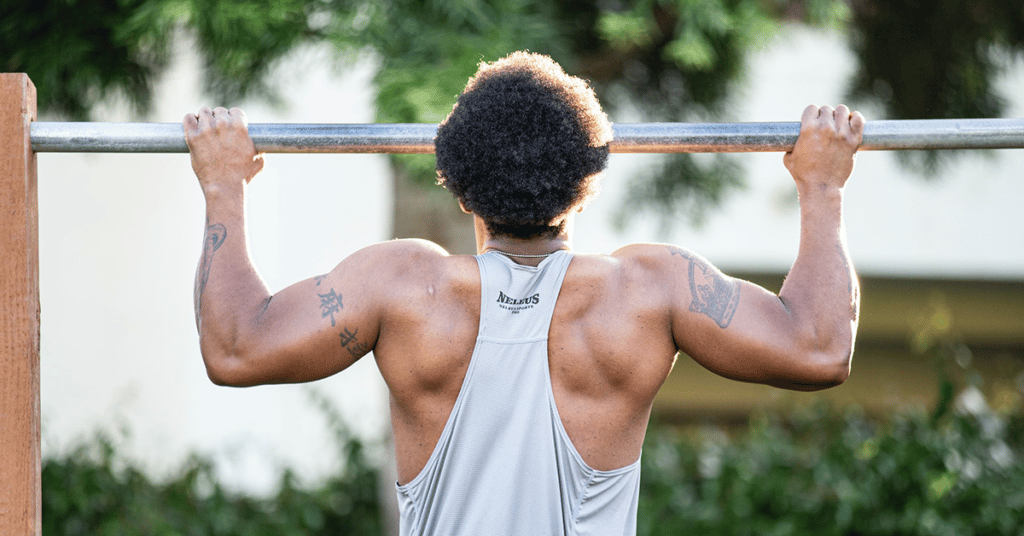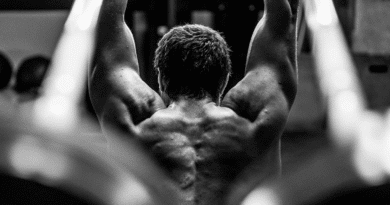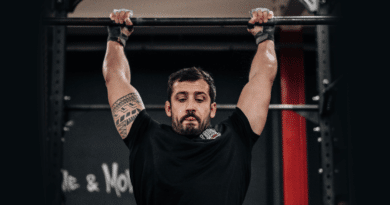Pull Up Best Guide: Benefits, Muscles Worked and Top Technique Tips
This complete guide to the Pull Up will teach you everything you need to know about this effective, simple and highly worthwhile movement.
What is a Pull Up?
A Pull Up is a bodyweight pulling exercise which works a large number of muscles in your back, shoulders, and arms at the same time.
They are commonly performed on a bar attached to a door frame or placed in a squat rack or power rack.
The exercise can be done anywhere with any kind of bar or pole that’s strong enough to hold your weight (such as in a tree).
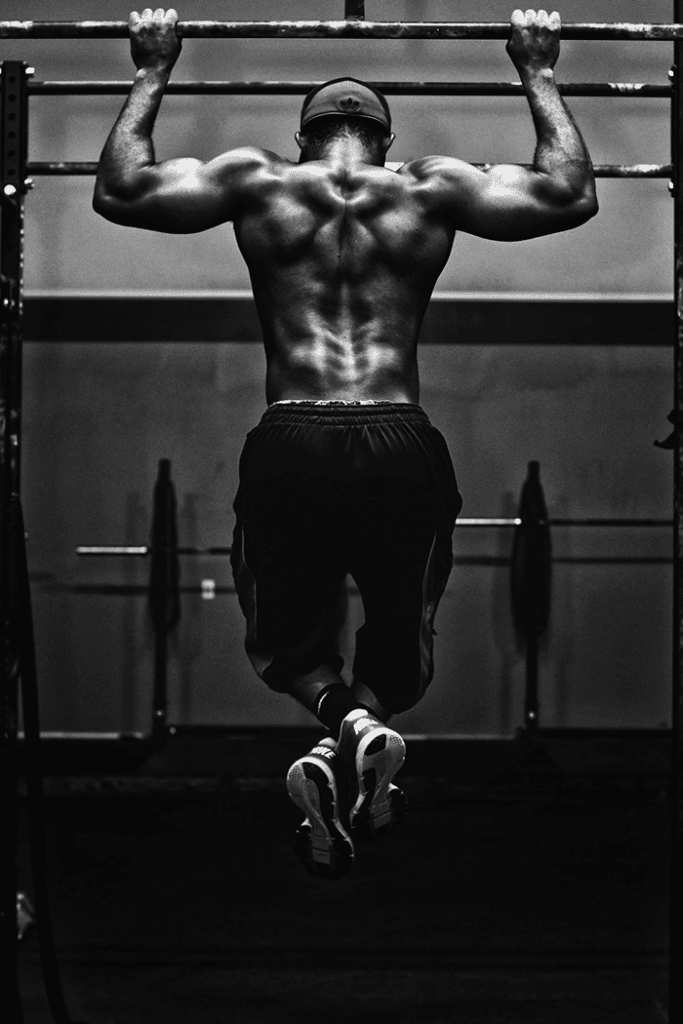
They can also be done with an assisted machine at many gyms around the world, which makes them accessible for even beginners who aren’t strong enough yet to do them unassisted.
The exercise will help to improve muscle size and strength in your lats, core and biceps.
They also work your rear deltoids (shoulder), spinal erectors and other stabilising muscle groups throughout the entire body.
- What is a Pull Up?
- What are the Benefits of the Pull Up?
- What Muscles do Pull Ups Work?
- Pull Up Technique
- Pull Up Mistakes
- Not Utilising the Full Range of Motion
- How to Make Pull Ups Easier
- How to Make Pull Ups Harder
- Training Tips for Pull Ups
- How to Get your First Pull Up
- Pull Up Progressions
- Pull Up Variations
- Pull Up Alternatives
- Pull Ups Sets and Reps
- Are Pull Ups Suitable for Beginners?
- How Many Pull Ups is Good?
- Do Pull Ups Give you Abs?
- What are the Disadvantages of Pull Ups?
- How Often Should I do Pull Ups?
- Why are Pull Ups so Hard?
- Do Pull Ups Build Muscle?
- Do Pull Ups Build Strength?
- Pull Up vs Chin Up: What’s the Difference?
- How Do I Get Stronger at Pull Ups?
- Are Pull Ups Harder for Taller Guys?
- How Many Pull Ups Can Navy Seals Do?
- Conclusion
What are the Benefits of the Pull Up?
They are an incredibly versatile exercise, and can be adapted to suit all levels of fitness.
While they’re great for beginners and advanced lifters alike, there are a few things you should know about them before you start doing them.
Work Multiple Extra Muscle Groups
First off, they work your back muscles as well as your arms and abs. When you pull yourself up, you use your bodyweight to lift yourself up into the air using only your arms, core and upper body (the same way that you might pull yourself up with a rope).
Using this method also helps develop core strength because it requires holding onto something while using the weight of your body against it.
They are a Compound Exercise
They are considered a compound exercise because they work multiple muscle groups at once (in this case: back, arms and core).
They Don’t Require much Equipment
You can perform this movement on a tree or scaffolding if you don’t have access to a bar.
This makes them a tremendously accessible exercise for all athletes to include in their training program.
What Muscles do Pull Ups Work?
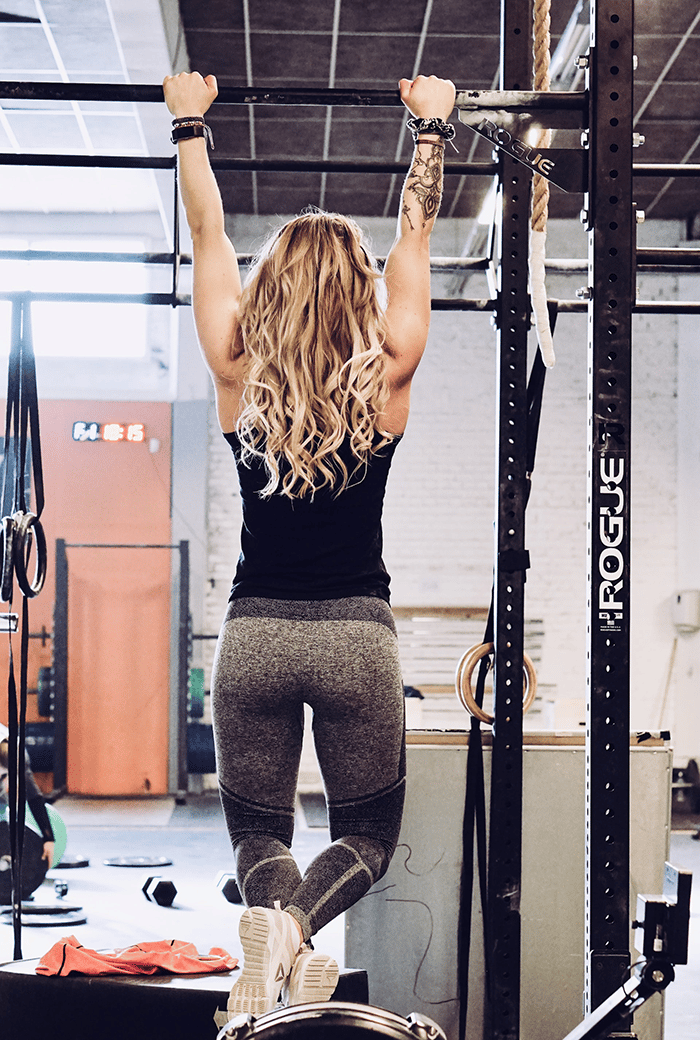
Pull ups work numerous muscles groups at the same time.
Here’s a quick breakdown:
- Back
- Biceps
- Triceps
- Chest (pectoralis major, anterior deltoids and pectoralis minor)
- Shoulders (anterior deltoids, teres major and medial deltoids)
- Core (abdominals)
Pull Up Technique
Work through the following steps to perfect your movement:
- Start with a dead hang and on overhand grip
- Inhale and brace your core, grip and glutes
- Pull your chest to the bar
- Reverse the movement and lower your body back to the starting position
- Exhale
- Keep your body straight
- Don’t swing or kick your legs
Pull Up Mistakes
They are an excellent exercise for developing the upper body and arms, but they can also be tricky if you’re not doing them properly.
Here’s a list of some common mistakes that you should avoid to get the most out of this workout staple:
Not Utilising the Full Range of Motion
Make sure that you always return to the fully extended dead hang position for every rep.
This will maximise the difficulty of the movement and maximise your results.
Using Momentum to Power Each Rep
This article describes the Strict Pull Up.
Other forms of the exercise exist where momentum is used to generate a kipping movement. These are known as kipping or butterfly pull ups and are common in CrossFit® and functional fitness workouts.
For building strength and muscle, stick to the strict variation and do not use momentum or any kind of swinging to provide extra power.
How to Make Pull Ups Easier
There are many ways to make pull ups easier.
Getting to the Bar
Firstly, if you cannot do a standard P Up, try using a chair or box to help you get up to the starting position.
Banded P Ups
You can also use a band to assist with your range of motion and power.
Use Negative Reps
If you don’t yet have the strength to pull yourself upwards, jump up to the chin over bar position then slowly lower yourself back down to the dead hang.
This will also build strength and help your body get used to the movement.
How to Make Pull Ups Harder
There are several ways to increase the difficulty of the movement:
- Use a weighted vest or weighted belt
- Perform P Ups on a rope
- Use tempo reps to create more time under tension
- Pause at varying stages of the lift
Training Tips for Pull Ups

To get the most out of your training, you should keep the following in mind:
Use a Variety of Grips
The grip you use while doing pull ups will largely determine how your muscles are worked.
If you are just starting out with this exercise, try using an overhand grip (palms facing away from you).
As you get stronger and more comfortable with them, gradually move on to other grips such as reverse grip (palms facing toward each other), underhand grip (palms facing down), and mixed grip (no one palm facing up or down).
Use Different Equipment
This exercise changes dramatically based on the width or the bar or even using ropes and towels.
Challenge yourself by experimenting with these differences in equipment.
How to Get your First Pull Up
Build up strength with Ring Rows and Lat Pull Downs.
Use banded P Ups and negative reps in the next stages of your progressions.
Rinse and repeat until you get your first rep!
Why you should use the Inverted Row
Pull Up Progressions
In order to build the strength and endurance required to do a pull up, you need to start with a progression that is both within your physical capabilities and serves as a foundation for the more difficult exercises.
These are:
- Ring Rows
- Inverted Bar Rows
- Banded P Ups
- Assisted P Ups
Pull Up Variations
Add these into your training if you need to keep your training fun, varied and challenging.
- Weighted P Ups
- Neutral Grip P Ups
- Wide Grip P Ups
- Close Grip P Ups
- Archer P Ups
- Mixed Grip P Ups
- One Arm P Ups
Pull Up Alternatives
Try these Alternatives:
Assisted P Ups
The assisted pull up machine is a piece of equipment that allows you to do the exercise while partially supported.
You can also do assisted pull ups by having someone hold your legs or torso as you perform the movement.
Negative P Ups
This alternative means that you slowly lower yourself over time.
Reverse Resistance Band Curls
Not an actual Pull Up, this can help to enhance your forearm and grip strength for the full exercise.

Pull Ups Sets and Reps
Muscle
They are a great way to build upper body strength.
In order for your muscles to grow, you need to stress them in such a way that the muscle fibres tear and then rebuild themselves. This is called muscle hypertrophy (growth).
If you don’t push yourself beyond your comfort zone, you won’t see much progress at all.
Aim for 3 – 5 sets of 6 – 12 reps with rest periods of no longer than 45 seconds between sets.
Strength
Perform 3 – 5 sets of 3 – 6 reps. Rest for 2 minutes or more between each set.
Are Pull Ups Suitable for Beginners?
Yes, although they are difficult.
Some individuals find the exercise much easier than others. As a result beginners will often start from wildly different starting points.
As a bodyweight exercise they are safe and effective movement to add into your training.
We would recommend testing yourself to find your current level. Try to perform one max rep set (do as many as you can).
It doesn’t matter if you can’t do any yet, that is what the training is for!
Stay dedicated and work hard and you will get there!
How Many Pull Ups is Good?
There are many factors that influence this question.
It Depends on your Fitness Level
If you’re just starting out, aim for doing one or two reps of the exercise. With practice and dedication, you should be able to build up to doing more reps over time.
It Depends on your Goals
If you’re working toward a specific goal (such as completing a certain number of reps), then keep track of how many reps you can do at each workout until you reach that goal.
It Depends on your Age
They can be easier or harder depending on how old someone is.
Obviously, the exercise tends to be easier for younger athletes will greater ratios of muscle mass.
Do Pull Ups Give you Abs?
Yes, they will contribute towards a six pack if that is your goal.
Nutrition is the primary factor when it comes to lowering body fat levels to the point that abs are visible.
As an exercise they work the core, as it must stabilise and control the body through the full range of motion.
What are the Disadvantages of Pull Ups?
They are hard. This is both an advantage (hard, effective exercises make you strong) and a disadvantage as many people can become discouraged if they cannot perform the exercise.
How Often Should I do Pull Ups?
2 – 4 times a week is a good starting point depending on your goals.
Why are Pull Ups so Hard?
They are hard because they require a lot of strength and coordination.
They also demand the core to stabilise the body and the hands to grip the bar tightly.
Additionally, there is nowhere to hide. A full rep from a dead hang position is tremendously effective for your body.
Many people cheat the exercise by performing partial reps. But remember, always go for quality over quantity.
3 good reps are better than 10 poorly performed partial reps.
Do Pull Ups Build Muscle?
Yes, they build muscle.
If your body is not used to working out, then you are going to be able to gain more muscle initially.
Make sure you are pushing your limits, eating smartly and sleeping well if you want proper results.
Do Pull Ups Build Strength?
Yes, the exercise will help you build strength.
They are a compound exercise that work many muscles in your body, including muscles in your back, arms and shoulders.
While there are other ways to build upper body strength using machines or weights alone, they force you to use multiple muscle groups at once for maximum gains.
They also develop good motor skills that are necessary for more complex exercises like Handstands and Muscle Ups.
Pull Up vs Chin Up: What’s the Difference?
Pull ups are performed with a pronated grip.
This means that the palms of your hands are facing away from you, as opposed to chin ups which use a supinated grip—your hands should be facing toward you.
Chin ups are easier for most people to perform than P Ups because they don’t require as much shoulder flexibility. So, if you’re just starting out or just want to get in shape, chin ups may be what you need.
They will give you better results if your goal is upper body strength; they also have more carry over into other exercises and are often more difficult than chin-ups.
If neither option appeals to you or if it’s just too hard to decide between them right now, try doing both!
How Do I Get Stronger at Pull Ups?
The best way to get stronger is by practicing, practicing, and more practicing.
Even if you haven’t done a single rep in your life, it’s never too late or too early to start.
If you don’t have access to a bar in your home gym, try doing inverted rows until you’re strong enough for regular pull-ups.
Once you’ve got the hang of this movement and are ready for more challenging variations, consider using tools like weight vests and weighted backpacks.
These will make each rep feel much heavier than usual—which will force your muscles to work harder so that they can get stronger over time without burning out as quickly.
Are Pull Ups Harder for Taller Guys?
They are a bit more challenging for tall people. The taller you are, the longer the range of motion and the longer your lever arm is. This makes it harder to pull yourself up because of leverage.
The good news is that there are many ways to compensate for this; many different variations exist which help reduce these differences in strength between shorter and taller individuals.
How Many Pull Ups Can Navy Seals Do?
Whether you’re looking to join the Navy Seals or just want to be stronger, this movement is an important exercise. It’s also one of the best ways to build muscle and blast fat.
The average person can do anything between 2-12 reps on a good day, but if you want to be able to do 100 reps like Navy Seals, there are several things you can do:
- You can start doing 1 P Up every day for 100 days in a row
- You can wear a 20kg weight vest if you are already advanced
Conclusion
This movement is one of the simplest and best bodyweight exercises that exists.
It is accessible and versatile, and can be easily scaled up or down to suit any athlete and their training experience.

